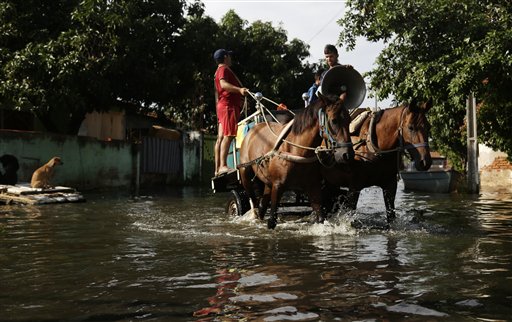Five dead, 150,000 evacuated in Latin America floods

Men selling vegetables drive their horse-drawn cart through a flooded street in the Tacumbu neighborhood of Asuncion, Paraguay, Wednesday, Dec. 23, 2015. The Paraguay River is at its highest level since 1984 and threatening the poor districts that surround the capital, forcing about 100,000 people to shelters. AP PHOTO
ASUNCION, Paraguay—Flooding dampened Christmas eve celebrations in parts of Latin America on Thursday, leaving five people dead and driving almost 150,000 from their homes in Paraguay, Argentina and Uruguay.
Some 130,000 people have been forced from their homes across Paraguay, officials said, as President Horacio Cartes declared a state of emergency to free up more than $3.5 million in disaster funds.
Three people traveling Paraguay’s international Route 2, which links Asuncion and Foz de Iguazu in Brazil were killed when a tree fell on their vehicle before dawn.
Another woman traveling by motorcycle in Asuncion was killed by a falling tree overnight, official sources told Agence France-Presse (AFP).
The National Emergency Secretariat (SEN) reported a dozen other similar incidents in the capital.
The agency’s head of operations, David Arellano, said rescue and evacuation operations were underway for dozens of families in the face of floodwaters from the Paraguay River.
Around the capital Asuncion 125,000 homes were without power and 17 power distribution centers knocked out across the country.
Northeastern Argentina also reported widespread disruption and one fatality from the worst flooding in half a century.
A 13-year-old boy was electrocuted by a power cable while trying to assess storm damage to his home in the city of Corrientes, local media reported.
In Entre Rios province at least 10,000 people were evacuated, with Concordia, a city of some 170,000 on the banks of the Uruguay River, the worst affected with nonstop rain throughout the night, Mayor Enrique Crest said.
“This is the worst flooding in 50 years,” he said, adding that although “flooding was predicted due to El Nino, no one thought that it would be so substantial.”
The city is located 18 kilometers (11 miles) from the Salto Grande dam, which was helping to hold the waters back, but was nearing its full capacity, Crest said.
The governor of Entre Rios said the total number of evacuees across the province could rise to “between 16,000 to 20,000.”
Argentina’s vice president, Gabriela Michetti, traveled Thursday to the affected region to view the damage and assess disaster relief needs.
The country has declared a state of emergency for the Panama, Uruguay and Paraguay rivers and their tributaries, following exceptionally high rainfall.
In November and December, the Rio de la Plata river basin in Argentina’s northeast received between 150 and 300 millimeters more rain than is typical for the period, the farm industry ministry said in a statement.
Uruguay on Wednesday also declared a state of emergency in three northern departments affected by flooding.
The number of displaced people reached almost 5,500 Thursday, as the situation worsened.














